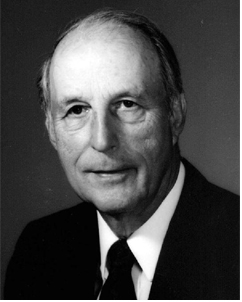Dr. Joseph C. Moquin
 A native of Middleboro,
Massachusetts, Joseph C. Moquin interrupted his education to serve as an Engineer lieutenant in World War II.
After the war, he completed his Bachelor of Science degree in Industrial Engineering at Washington University in
St. Louis. In 1952, he joined the staff of the Army Ordnance Engineering Management Program at Rock Island
Arsenal.
A native of Middleboro,
Massachusetts, Joseph C. Moquin interrupted his education to serve as an Engineer lieutenant in World War II.
After the war, he completed his Bachelor of Science degree in Industrial Engineering at Washington University in
St. Louis. In 1952, he joined the staff of the Army Ordnance Engineering Management Program at Rock Island
Arsenal.
In 1956, MG John Medaris, Commanding General of the newly formed Army Ballistic Missile Agency (ABMA) at Redstone Arsenal recruited Moquin to serve as Chief of Management Services. Under the jurisdiction of the Chief of Ordnance, ABMA was responsible for the Army's guided missile programs, to include the launching of America's first satellite, Explorer I, in 1958, an event that brought national attention to Redstone Arsenal and Huntsville, Alabama.
In 1958, a growing Army missile program led to the establishment of a new, larger agency, the Army Ordnance Missile Command (AOMC). Medaris headed up this new agency and chose Moquin as his Chief Management Engineer; in this position, Moquin was responsible for planning, programming, and managing studies for a wide range of missile programs.
In 1959, Moquin left government service to join Brown Engineering Company as Executive Vice President. Brown Engineering, which became Teledyne Brown Engineering in 1967, provided technical and management support for several important Army missile programs, notably ballistic missile defense programs such as Nike-X, Sentinel, and Safeguard.
By the early 1960's, Brown Engineering had outgrown its building. Moquin and Brown's president, Milton Cummings, decided to build new facilities. However, Moquin soon devised a far more ambitious expansion plan. He convinced the Huntsville City Council to rezone 3,000 acres on the west edge of town as a research park to attract other aerospace and high-technology companies. Thus, the Huntsville Research Park, later renamed the Cummings Research Park, was born; and companies rapidly established facilities there to support missile programs for both the Army and the new National Aeronautics and Space Administration (NASA). NASA, which assumed responsibility for the nation's space program in 1958, established its Marshall Space Flight Center at Huntsville in 1960.
In 1966, Moquin was promoted to President of Brown Engineering. He served as President and then Chief Executive Officer until his retirement in 1989. In recognition of his contributions and his engineering and management expertise, the University of Alabama and the Southeastern Institute of Technology have awarded him honorary doctorates. His legacy, the Cummings Research Park, once a patchwork of old cotton fields, now contains 220 companies employing 25,000 people, most of whom provide support for Army and NASA missile and space programs.